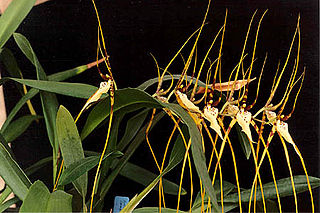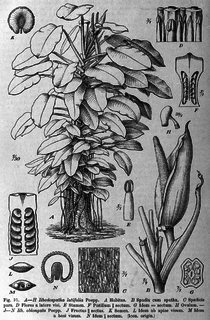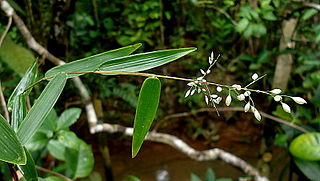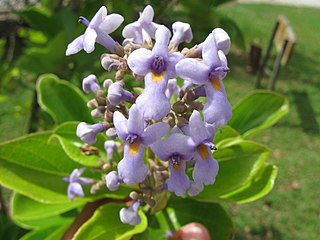
Brassia is a genus of orchids classified in the subtribe Oncidiinae. It is native to Mexico, Central America, the West Indies, and northern South America, with one species extending into Florida.

Echinodorus berteroi is an aquatic plant species in the Alismataceae It is native to the southern and central parts of the United States, as well as Central America, the West Indies, and South America as far south as Argentina.

Dicranopygium is a genus of plants belonging to the family Cyclanthaceae, first described as a genus in 1954. They are distributed in the Neotropical realm from southern Mexico to Peru.

Renealmia is a plant genus in the family Zingiberaceae. Its members are native to tropical Africa and tropical America. In Peru, fruits and tubers are sources of indigenous dyes. and indigenous medical treatments for leishmania and malaria In Colombia, it is used to treat snakebite. Bracts and leaves can serve as phytotelmata, retaining small quantities of water that offer habitat for other organisms.

Rhodospatha is a genus of plant in family Araceae. It is native to South America, Central America, and southern Mexico.

Stenospermation is a genus of plant in family Araceae native to South America and Central America.
Thoracocarpus is a genus of plants first described as a genus in 1958. It contains only one known species, Thoracocarpus bissectus a hemiepiphytic vine. It is native to Costa Rica, Panama, Cuba, Trinidad and Tobago, and South America.

Sievekingia is a genus of orchid, comprising 20 species found in Central and South America, from Nicaragua east to the Guianas and south to Bolivia.

Parodiolyra is a genus of Neotropical plants in the grass family.
- Parodiolyra aratitiyopensisJ.R.Grande - Venezuela (Amazonas)
- Parodiolyra colombiensisDavidse & Zuloaga - Colombia (Caquetá)
- Parodiolyra lateralis(J.Presl ex Nees) Soderstr. & Zuloaga - Nicaragua, Costa Rica, Panama, Colombia, Venezuela, Guyana, Suriname, Ecuador, Peru, Brazil
- Parodiolyra luetzelburgii(Pilg.) Soderstr. & Zuloaga - Brazil, Colombia, Venezuela, Guyana, Suriname, French Guiana
- Parodiolyra micrantha(Kunth) Davidse & Zuloaga - Brazil, Colombia, Venezuela, Guyana, Suriname, French Guiana, Peru, Bolivia, Argentina, Paraguay
- Parodiolyra ramosissima(Trin.) Soderstr. & Zuloaga - Brazil (Bahia)
Uleiorchis is a genus of myco-heterotrophic flowering plants from the orchid family, Orchidaceae. There are two known species, native to Central and South America.

Rhynchostele is a genus of flowering plants from the orchid family, Orchidaceae, native to Mexico, Central America and Venezuela. The genus name is abbreviated as Rst. in the horticultural trade.

Sarcoglottis is a genus of flowering plants from the orchid family, Orchidaceae. It is widespread across much of Latin America from Mexico to Argentina, with one species extending northward into Trinidad and the Windward Islands.

Bletia purpurea, common name pine-pink or sharp-petaled bletia, is a species of orchid widespread across much of Latin America and the West Indies, and also found in Florida. They are terrestrial in swamps or sometimes found growing on logs or stumps above the high tide mark.
Carex porrecta is a plant species known from Costa Rica, Colombia, Venezuela and Ecuador. It is found in humid forests at elevations of 1,600–2,600 metres (5,200–8,500 ft).

Burmannia capitata is a plant species widespread across the West Indies and much of Latin America. It grows in wet areas at elevations less than 100 m. It has been reported from Argentina, Belize, Bolivia, Brazil, Cuba, the Dominican Republic, Haiti, Jamaica, Puerto Rico, Trinidad & Tobago, Colombia, Costa Rica, French Guiana, Guyana, Honduras, southern Mexico, Nicaragua, Panamá, Paraguay, Suriname, Venezuela, and the United States
Bulbophyllum pinelianum, the rat-tail orchid, is a species of orchid in the genus Bulbophyllum. It is widespread across southern Mexico, the West Indies, Central America and northern South America. It is also reported from Florida but apparently now extinct in that state.

Ionopsis utricularioides, the delicate violet orchid, is an epiphytic orchid native to the warmer parts of the Americas. It is reported from Florida, Mexico, Central America, much of the West Indies including the Cayman Islands, South America as far south as Paraguay, and the Galápagos.
Diastatea is a genus of plants native to Latin America, mostly in Mexico and Central America but with one species extending southward along the Andes to Argentina.
- Diastatea costaricensisMcVaugh - Guatemala, Honduras, Nicaragua, Costa Rica
- Diastatea expansaMcVaugh - central Mexico
- Diastatea ghiesbreghtii(Kuntze) E.Wimm - southwestern Mexico
- Diastatea micrantha(Kunth) McVaugh - widespread from central Mexico to the Jujuy region of northern Argentina
- Diastatea tenera(A.Gray) McVaugh - southern Mexico and Guatemala
- Diastatea virgataScheidw. - southern Mexico

Cornutia is a genus of plants in the family Lamiaceae, first described in 1753. It is native to tropical parts of the Western Hemisphere: southern Mexico, Central America, West Indies, northern South America.
- Cornutia australisMoldenke - Ecuador, Brazil
- Cornutia coerulea(Jacq.) Moldenke - Jamaica
- Cornutia jamaicensisMoldenke - Jamaica
- Cornutia obovataUrb. - Puerto Rico
- Cornutia odorata(Poepp.) Schauer - Venezuela, Colombia, Ecuador, Peru
- Cornutia pubescensC.F.Gaertn. - French Guiana
- Cornutia pyramidataL. - southern Mexico, Central America, West Indies, Suriname, Venezuela, Colombia, Ecuador, Peru
- Cornutia thyrsoideaBanks ex Moldenke - Jamaica

Xyris jupicai, common name Richard's yelloweyed grass, is a New World species of flowering plants in the yellow-eyed-grass family. It is widespread in North America, South America, Mesoamerica, and the West Indies.















